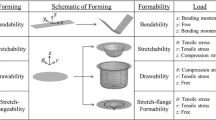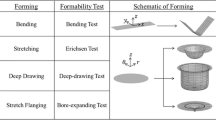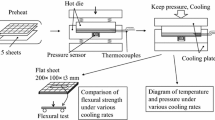Abstract
The forming processes at room temperature and under a warm condition have been investigated for carbon-fiber-reinforced plastic (CFRP) sheets consisting of thermosetting resin and continuous fibers used for mass production. While CFRPs consisting of thermosetting resin have the advantage of high strength, to subject them to press forming, in contrast to carbon-fiber-reinforced thermoplastics (CFRTPs), which consist of thermoplastic resin. When CFRP sheets are formed into the desired shape through plastic deformation, a higher-strength structural material easily applicable to mass production is obtained. To improve the formability of thermosetting CFRP sheets while retaining their strength, a suitable structure allowing plastic deformation under warm condition is proposed. The tensile stress obtained by a tensile test and the bending properties obtained by a stretch-bending test indicate the strength and formability, respectively. A stretch-bending test is a bending test in which a tensile load is placed on a sheet, and it has the characteristics of a bending test and a deep drawing test. A suitable structure containing prepreg layers to allow plastic deformation based on the relationship between the bending load and the results of specimen observations is revealed.














Similar content being viewed by others
References
Hull D, Clyne T W (1981) “An Introduction to Composite Materials”. Cambridge Solid State Science Series
Demeri, M (2013) Advanced high strength steel application guidelines. International Iron & Steel Institute. ISBN-13:978-1-62708-005-7
Yanagimoto J, Ikeuchi K (2012) Sheet forming process of carbon fiber reinforced plastics for lightweight parts. CIRP Ann Manuf Technol 61(1):247–250
Jeong C, Oya T, Yanagimoto J (2013) Analysis of fracture behavior and stress–strain distribution of martensite/austenite multilayered metallic sheet. J Mater Process Technol 213(4):614–620
Uriya Y, Ikeuch K, Yanagimoto J (2014) Cold and warm V-bending test for carbon-fiber-reinforced plastic sheet. Procedia Eng 81:1633–1638
ISO-527-1 (1993) Plastics – Determination of tensile properties –Part 1: general principles. ISO, Geneva
Cao S, Zhis WU, Wang X (2009) Tensile properties of CFRP and hybrid FRP composites at elevated temperatures. J Compos Mater 43(4):315–330
Meyer-Piening HR, Farshad M, Geier B, Zimmermann R (2001) Buckling loads of CFRP composite cylinders under combined axial and torsion loading–experiments and computations. Compos Struct 53(4):427–435
Demeri MY (1981) The stretch-bend forming of sheet metal. J Appl Metalwork 2(1):3–10
Tang G, Chang D, Wang D, He J, Mi W, Zhang J, Wang W (2012) Mechanical property improvement of carbon fiber-reinforced PTFE composites by PA6 filler dispersion. Polym Plast Technol Eng 51(4):377–380
Uriya Y, Ikeuchi K, Yanagimoto J (2014) Enhanced formability of thin carbon fiber reinforced plastic sheets in cold/warm embossing with ductile dummy sheets of different thicknesses. Int J Mater Form. doi:10.1007/s12289-014-1184-9
Sarkar BK, Mukherjee MK, Natarajan A (1982) A modification of the rule of mixture in estimating strengths of a composite. Mater Werkst 13(8):269–273
Abot JL, Yasmin A, Jacobsen AJ, Daniel IM (2004) In-plane mechanical, thermal and viscoelastic properties of a satin fabric carbon/epoxy composite. Compos Sci Technol 64(2):263–268
Timoshenko S, Young D H (1968) “Elements of strength of materials”. D. Van Nostrand Company, Inc., pp 231–235
Ozaki JI, Manabe KI (2003) Thermoforming of textile composite pipe fittings. JSME Int J Ser A 46(3):426–431
Takeda T, Takano S, Shindo Y, Narita F (2005) Deformation and progressive failure behavior of woven-fabric-reinforced glass/epoxy composite laminates under tensile loading at cryogenic temperatures. Compos Sci Technol 65(11):1691–1702
Author information
Authors and Affiliations
Corresponding author
About this article
Cite this article
Uriya, Y., Yanagimoto, J. Suitable structure of thermosetting CFRP sheet for cold/warm forming. Int J Mater Form 9, 243–252 (2016). https://doi.org/10.1007/s12289-015-1227-x
Received:
Accepted:
Published:
Issue Date:
DOI: https://doi.org/10.1007/s12289-015-1227-x




